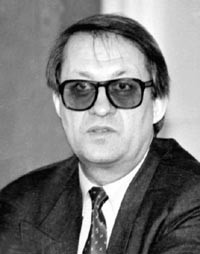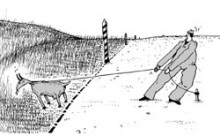LET’S NOT GET PANIC-STRICKEN
There was an overemotional response in Ukraine to EU dignitaries saying that Ukraine’s EU membership makes no sense at the time, that the possibility won’t even be considered in the next 10-15 years. In fact, Ukraine has not raised the matter in this context. The president’s message “European Choice” points to ten years (till 2011) as a period in which to create the prerequisites of this membership. At the same time, the emphasis is on the European integration strategy as Ukraine’s homework in the first place, a strategic guideline determining the underlining principles of internal transformations. I have stressed that Ukrainian society threatens to become Latin American and that the process is deepening. I mean a narrow domestic market and export-oriented economy, profound stratification of the population, and absence of the middle class. Getting to be like a Latin American country means that Ukrainian society is veering off the European integration vector. We must overcome this trend and prove our adherence to the idea of European integration, primarily along these lines.
At the same time, we must show political restraint and understanding of the profound complexity of EU expansion. Expanding European integration is a relatively new field of endeavor for the Union. It emerged after tearing down the Berlin Wall and should be considered in the context of evolution from personal hegemony to a multipolar international community, enhancing the geopolitical and civilizational self-sufficiency of the European community of nations, protection from US dominating influence. If one were to consider EU expansion at this angle, it becomes obvious that Ukraine’s intentions are objectively preconditioned. It is a process of mutual interest; EU is as interested in a civilized democratic Ukraine as Ukraine is in EU. Another factor is the understanding that EU expansion cannot be forced. This process takes “small steps” and Western European countries have followed this course for almost 50 years. At present, the stated three-stage expansion project is being implemented; EU will be joined by ten countries before 2004, along with another two before 2007, followed by an adjustment period of 5-7 years. And then perhaps another expansion round with Ukraine among the candidate members.
I am convinced that this situation is no tragedy for Ukraine. We must understand that EU expansion begets a problem we know only too well, that of the “younger brother” — or inferiority. Agrarian subsidies are a vivid example. In 2004-07, they will amount to a mere 25% for the new EU members, compared to the old-timers. The percentage will gradually increase, reaching 40% in 2007, with a subsequent annual 10% increment, so that they will get the full amount in 2013. Under the circumstances farmers in the new member countries may well fail to endure the severe competition within the Union, as evidenced by the differences at the Copenhagen summit, concerning Poland’s membership (almost 20% of the able-bodied Poles are in the agrarian sector).
This example alone shows how much has to be accomplished in getting closer to the European standards. Here an accelerated rate of economic growth comes first (e.g., at least 5-6% annual GDP increment in Ukraine) and competitiveness — higher by an order than what we have in Ukraine. This requires utmost efforts on the part of all society and time, meaning a lot of purposeful and painstaking work. The current average per capita GDP in the EU countries (given buying capacity parity) is $21,300. In the candidate members, it is $5,500- 5,600 (Bulgaria and Romania), $6,500-8,000 (Lithuania, Latvia, Estonia). Ukraine registers $4,200 — or higher by 40%, allowing for the shadow economy. In other words, we are not way behind by this synthesized index, the more so that we already meet the so-called Maastricht criteria of EU membership, combining three basic indices: annual inflation rate (up to 2%), budget deficit (up to 3% GDP), and public debt (up to 60% GDP). By the existing economic development parameters we answer these criteria even at this stage.
Ukrainian-EU trade cooperation is expanding. In 10 months of this year alone, the Ukrainian share of exports to EU countries increased from 17.4 to 19.2% (that of Russia went down from 22.2 to 17.1%). At present, Ukrainian exports to EU member and associate member countries exceeds those to the CIS countries by 41.3%. In nine months it had increased from 36.8 to 41.2%. It is a very encouraging trend that will doubtlessly grow stronger.
Everything stated above allows the following conclusion: the biggest problem of Ukraine’s European integration is in terms of qualitative rather than quantitative changes in the economy and society. We must start moving in that direction, step by step, carrying out the president’s European integration strategy not in words, by general approving declarations, but in deeds. Public expectations from the new government are focused on this above all. We must secure a stable economic growth rate. This is very important, but what is even more important is actually moving forward to prevent another round of the merging of political power and property, and to overcome the bureaucratic arbitrary rule, for there is every indication that this arbitrariness is way above the indices of the former administrative system. We must take big steps on the road to the supremacy of the law and actual free enterprise, overcoming corruption and the attendant shadow economy. They are afraid to allow us entry to Europe primarily because of these phenomena. The skidding market reform and the ineffectiveness of everything previously done in that direction are explained by precisely these factors. I am convinced that the criteria of the new government’s performance lies in this plane.
EURASIAN LOSSES
Ukraine’s European course and relationship with the Russian Federation present an extremely pressing problem. We must proceed from the understanding that Russia has played and will continue to play an increasingly important role in European politics. Europe is also interested in deepening cooperation with Russia in all spheres of social relationships: politics, economy, military cooperation, and in the humanitarian domain. As does Ukraine, Russia strives to integrate into the European economic space. In view of this, the Russian vector will remain an important principle of the Ukrainian foreign policy. Strengthening ties with Russia is, in fact, one of the prerequisites in implementing Ukraine’s European policy, an inalienable component of the European integration process.
At the same time, our strategy with regard to Russia should be considered as one subordinated to European integration. It is one of the key points in the president’s European Choice strategy that cannot be doubted for a moment. We must also bear in mind that Russia has been developing relationships with the European Union in a somewhat different format. Both countries have different objectives, so they are using different mechanisms in the integration process. Russia does not purport to become a member of the Union, it claims the status of an independent Eurasian integration center.
Broaching this subject, it is important to understand that for Russia the Eurasian Economic Community (currently made up of Russia, Belarus, Kazakhstan, Kyrgyzstan, and Tajikistan) is a geopolitical rather than economic project, aimed at restoring the status of Great Russia, asserting it as an independent international integration center. It is aimed at enhancing Russia’s predominant influence in the post-Soviet space. Ukraine is, actually, the critical mass in making this project a reality. The project’s geopolitical importance largely depends on whether or not Ukraine becomes a party thereto in full measure. Russia’s heavy political pressure on Ukraine is mounting and there are grounds for it. In view of this we all expect that the new government, as did the previous one, will show understanding of the fact that Ukraine’s membership of the Eurasian Economic Community would be tantamount to changing its geopolitical orientation and actually abandoning the European integration course.
This admonition rests on a solid footing. The long-term advantages of Eurasian membership (constantly emphasized by Russia) seem rather questionable. The community’s practice points to a lowering commodity turnover among the members, ditto exports to Russia, ditto membership foreign trade balance. No evening up of prices of energy resources has been envisaged. Under the circumstances, Ukraine’s accession would provide Russian goods, made using cheap energy resources, an easy access to the Ukrainian market and flood it. Also, this membership does not rule out the possibility of restricted commodity access to domestic markets by using non-tariff instruments. Evidence of this is found in regular antidumping investigations initiated by Russian manufacturers, including those against Kazakhstan as a community member. One ought to remember that the EAEC members have not succeeded in agreeing on lower customs duties on vehicles and so on. All told, this economic community has failed to show an innovating potential to more effectively enlist the post-Soviet countries in the globalization process.
Summing it all up, it is safe to assume that even tentative steps toward Eurasian integration would have a negative effect on Ukraine’s European integration plans, while causing tangible domestic political disturbances. Eurasian membership would be bad for Ukraine’s international image as a polity following a reasonable foreign political course, in full conformance with the principles of independence and sovereignty. It would further noticeably change the geopolitical situation in Europe, causing the West to drift even further away from Ukraine as a country lacking a clear-cut geostrategic orientation and being amorphous in its strategic aspirations. While losing its initiative in the Western direction, Ukraine would lose its influence and the opportunity to become a leader in the whole region. Ukraine’s political course would be regarded only in the context of Russia’s national (primarily geopolitical) interests.
To this end, the following options should be considered most practical: (a) Ukraine’s current status as an EAEC observer, (b) development of bilateral relationships with CIS countries, primarily with Russia; (c) stepping up efforts to join WTO; (d) political efforts to form a free trade zone within the CIS, which does not contradict the principles of Ukraine’s European integration course.
* * *
It is important to understand that Ukraine’s European integration strategy is not a fiction invented by politicians but the natural result of Ukraine’s national independence, rooted in the history of the Ukrainian people, mentality, and democratic tradition. It reflects the younger generation’s desire to see their country as an inalienable component of a united Europe. All current hardships notwithstanding, we must find a way to give a fresh impetus to our movement in that direction.








